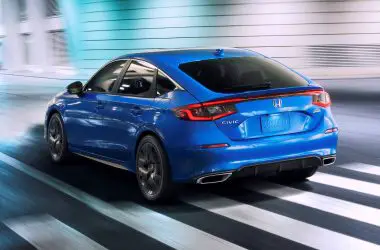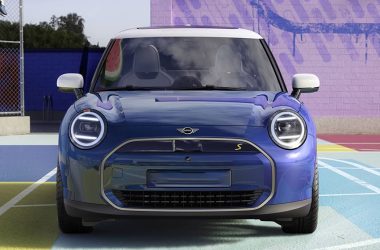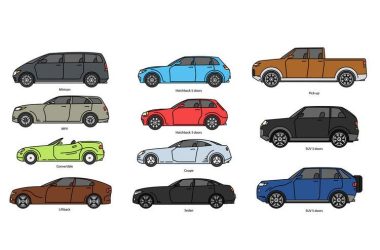For Honda Civic enthusiasts, a common question that arises is whether the standard Civic hatchback models can be modified and tuned to the same extent as the higher-performance Si trim.
While hatchbacks and Si models share some core components, there are differences in their engines and drivetrains that impact just how far each can be tuned.
In this article, we’ll examine the key factors that determine modding potential on 10th generation Honda Civic hatchbacks and Si models. We’ll look at their engines, transmissions, internals, and supporting components to understand where each excels and what upgrades may be necessary to push more power. Our goal is to provide Civic owners with a realistic perspective on tuning ability so you can plan mods smartly. Let’s get started!
Engine Basics
When looking at engine tuning, one of the most important considerations is the base motor itself. The 10th generation Civic Si uses a 1.5L turbocharged 4-cylinder which is similar to the 1.5T EarthDreams engines also found in the standard Civic hatchbacks. However, there are some key differences:
- The Si employs a higher compression ratio (10.3:1 vs 10.6:1) along with unique pistons and connecting rods. This allows it to handle more boost pressure and power.
- The Si uses VTC (variable cam timing) on the exhaust cam in addition to the intake cam for optimized power delivery.
- The Si has a freer flowing exhaust manifold and turbine housing in the turbocharger.
While not revolutionary changes, these design tweaks do allow the Si engine to produce around 40 more peak horsepower from the factory. The higher compression and forged internals also make it better suited to handle additional power from mods down the road. Both engines offer strong tuning potential, but the advantage goes to the Si here.
Intake/Exhaust Mods
Let’s start with basic bolt-on modifications like air intakes and exhaust systems which can net solid gains on both the standard hatchback and Si models. Civic X forums are filled with dyno results from members adding intakes, downpipes, intercoolers and cat-backs to their 1.5T engines. The hatchback may require supporting mods sooner, but intake and exhaust work still forms the foundation of any turbo Honda build.
For intake options, Honda’s tuned air box offers decent airflow already, so gains from just an intake pipe or filter will be modest. Larger cold air intakes can potentially show 10+ HP over stock. And short ram intakes often measure even higher peak gains, at the expense of heat soak. So proper CAI placement and using heat shielding is advised.
Aftermarket downpipes and full turbo-back exhausts open up flow on the back end of the 1.5T. Expect to see significant gains here, often 30HP or more once properly tuned. Just know that louder exhausts bring more attention from law enforcement and noise complaints from neighbors.
Engine Tuning
The ECU engine management is where the most power is unlocked from Honda turbo engines. Cobb, Hondata, KTuner and other Honda ECU tuners offer Stage 1 and 2 calibrations for the 1.5T which target more boost, timing, fueling and torque delivery. With just a tune on an otherwise stock turbo Civic, around 50-70HP can be added.
The Si engine will have a bit more headroom thanks to those forged internals we mentioned earlier. The hatchback’s power may be tapered off sooner by the ECU due to knock detection. But both respond very well to proper tuning. And flashing your ECU also allows features like launch control, no-lift shift, flat foot shifting and rev hang reduction that make driving more enjoyable.
Transmission and Drivetrain
Another area where the Si pulls ahead for tuning purposes is its transmission. The standard Civic hatchback’s CVT automatic is limited in the amount of torque it can handle reliably. Exceeding those limits will quickly burn up your transmission clutch packs. So while engine power can still be added, the CVT becomes the weak link.
The 6-speed manual transmission in the Si is built stouter from the factory with performance use in mind. Various builders have pushed them to handle 400+ ft-lbs of torque. So it’s far more ready to cope with added motor output. Though upgrading the clutch on any manual Civic is still a good safeguard once horsepower exceeds 300-ish.
For other drivetrain components, the Si again has the edge. The helical limited slip differential allows hard launching while reducing wheel spin compared to the open diff hatchback models. And the Si’s independent multi-link rear suspension keeps traction more consistent around corners versus the hatchback’s cheaper torsion beam style rear end.
Handling Upgrades
While the Si handles very well out of the box, the standard hatchback isn’t far behind in terms of agility. Good suspension tuning and sticky tires work wonders on any Civic platform. The SI does enjoy a slightly lower center of gravity thanks to a 15mm drop in ride height from the factory.
Lowering springs are a quick way to sharpen steering response and reduce body roll on both cars. Good sets typically drop around 30mm and can give a nice balance of improved handling and still livable daily ride quality. Coilovers let you fully customize ride height and shock stiffness, but do require professional installation.
Stickier high performance tires also transform handling for surprisingly little money. Consider the Michelin Pilot Sport 4S or Continental ExtremeContact Sport as sub-$150 options per tire that offer way more grip over stock rubber. Just make sure to budget for new tires more often as soft compounds wear quicker.
Upgraded anti-roll bars and strut braces help dial in steering and chassis balance further. The Si already has a larger rear sway bar, but the hatchback can close the handling gap somewhat through bars, strut bars and chassis bracing kits from Progress, Whiteline, Megan Racing or others.
Is the Si Ultimately More Tunable?
When it comes down to it, the Civic Si does have innate advantages over the standard hatchback when pushing big power numbers. Its engine internals, turbo setup, transmission and limited slip diff make it more of a blank canvas for modification straight from the factory.
That said, don’t think the base hatchback models are slouches by any means. There are plenty of examples out there modified to well over 300HP while remaining great daily drivers. They just may require more auxiliary upgrades sooner as power climbs into the big leagues beyond Stage 1 and 2.
Our advice? Start with simple bolt-ons, handling mods and an ECU tune on your hatchback to wake it up. Have realistic expectations, monitor engine vitals and enjoy those transformations first. Then down the road if you’re hungry for more, dig into the internals, fuel system and driveline upgrades to support bigger power goals.
Have fun with your Civic build, but also budget wisely and do your homework before getting too aggressive. Stay within safe parameters for your car and your own skill level as a driver. With some sensible modding and smart tuning, you can create an incredibly quick and grin-inducing Honda hatchback that suits your needs.
Fuel System Upgrades
When shooting for big power, upgrading the fuel system becomes necessary on both the Si and standard hatchback. The factory fuel pump, injectors and feed lines can only supply enough fuel for limited power gains before needing replacement.
Larger fuel injectors should be matched to your power goals and desired air/fuel ratios. Billet fuel rails allow better fuel delivery and pressure. Upgraded fuel pumps from Walbro, DeatschWerks or AEM push more volume at higher pressures to avoid leaning out.
An e85 conversion is also popular for 1.5T builds, taking advantage of ethanol’s superior cooling and octane over gasoline. Flex fuel kits, upgraded lines and larger injectors conditioned for e85 allow tapping into that extra performance potential. Just be aware of decreased fuel economy and fuel system corrosion over time.
Turbocharger Upgrades
The factory turbo on the 1.5T is efficient and responsive, but leaves power gains on the table. Larger turbochargers become necessary for supporting 400HP+ builds on this platform.
Popular options are hybrid turbos like the Borg Warner EFR 6258 or G25-550/600 which offer great spool with larger turbines for higher peak boost. Or large frame “GTX” style turbos from Garrett or Precision can support 500+ horsepower but require more supporting mods.
A turbo upgrade also requires an exhaust manifold and wastegate to handle increased pressures. And a front mount intercooler keeps intake air temperatures in check. With proper tuning and fueling, these big snails unlock way more top end while retaining drivability.
Internal Engine Builds
For those chasing huge power beyond about 400-450HP at the wheels, the factory bottom end components become fragile. Pistons will crack under detonation and extreme cylinder pressures.
A built motor employs forged aluminum or nickel-plated steel pistons with thicker ring lands and heat-treated wrist pins. Forged H-beam rods replace the factory I-beams for reliability under big boost. Some builders upgrade crankshaft bearings as well.
Head studs should also be used in place of torque-to-yield head bolts for proper clamping force. Wiseco, ACL, Eagle, Manley and CP-Carrillo all offer quality internals packages for the 1.5T engine family.
A built head goes hand-in-hand with built bottom end. Upgraded valve springs prevent valve float at higher RPMs. Ferrea and Supertech make lightweight valvetrain components like retainers and keepers for controlling those high-lift cams.
Having a reputable machine shop assemble your built motor ensures proper clearances and bearing tolerances. This level of engine build is not cheap, but required in order to run and be reliable at big turbo power levels approaching 500HP.
The Importance of Pro Tuning
No matter what modifications you make, proper tuning is absolutely crucial to both performance and engine longevity. The ECU maps control boost, timing, fuel and all vitals. A bad tune can destroy an engine in short order.
For moderate changes like intake and exhaust, a quality off-the-shelf tune usually suffices for Stage 1 and 2 builds. But once you move to upgraded turbochargers, injectors, internals and aux fuel, custom professional tuning is a must.
On-dyno tuning allows optimizing each calibration point based on actual sensor data from your engine versus theoretical targets. Good tuners like PRL Motorsports, 5150 Racing and TMTuning utilize ECU software logging and iterative testing for maximum performance and safety.
Remote tuning has also become popular for its convenience. Using a wired interface or wifi adapter, your tuner can access the ECU, make changes, log runs and send back revised maps from anywhere without needing the car on a dyno. Just be sure to thoroughly test all functions.
Don’t cut corners on tuning and data acquisition. Proper fuel, timing, knock control and boost by RPM maps ensure your built motor lives a long, fast life. The cost is small by comparison to the total investment in your modified Civic.
The Price of Big Power
Let’s talk budgets. Adding significant horsepower and pushing limits requires opening up your wallet. Entry level changes like intakes, exhausts, springs and stickier tires may only run a couple thousand dollars total. But big turbo builds with built motors and fuel systems often tally over $15,000 in parts alone once fully complete.
Figure another several thousand dollars for quality tuning time on a chassis dyno to dial everything in. Plus general shop labor, fluids, gaskets and other consumables that come with an intensive build. And maybe a thousand more for drivetrain upgrades to cope with all that twist.
None of this factors in the price of the car itself either. So while transforming a base model Civic hatchback into a 500HP monster is entirely possible, it entails a serious budget well north of $20-25k when done properly.
Our advice is to set reasonable goals for your time and money available. Not everyone needs or wants an ultra-high horsepower Civic. For many drivers, a simpler and less costly 300HP turbo build is more than enough and will still deliver joy in daily driving.
DIY vs Professional Builds
How much work you can perform yourself vs having a shop handle also affects end costs. While experienced mechanics may tackle jobs like bolt-ons in their own garage, pulling an engine or transmission and building it up requires advanced skills and tools.
Removing and fully building a motor can run $5,000 or more in machine shop and professional labor fees alone. Diagnosing drivability issues with a complex turbo build requires special equipment and know-how as well.
Evaluate your own mechanical abilities honestly. There’s no shame in letting qualified shops handle certain aspects that are over your head. Their expertise can actually save you money in the long run by avoiding costly mistakes.
Teaching yourself new skills like fabrication, tuning, wiring, etc has value too. Just know the limits of what can be done at home reasonably and be ready to pay for specialty services.
Adding Power…Reliably
Besides budgeting, the other crucial consideration with modifying any vehicle is maintaining reliability. Pushing hardware past its limits, even unintentionally, is how engines and drivetrains get destroyed.
That’s why we emphasize the importance of supporting mods, quality parts and professional assembly and tuning throughout any build process. Yes, you can make a Civic hatchback insanely fast. But keeping it together lap after lap requires planning.
Allow margins of safety with horsepower targets, boost levels, engine parameters, etc. Use the best components you can afford, not bottom-dollar knockoffs out of China. Work with shops and tuners experienced specifically with Honda turbo platforms.
Monitor engine vitals like air/fuel ratios, coolant temperatures, oil pressures and knock continually when testing and tuning. Log data in a variety of conditions and have it analyzed by your tuner. Don’t ignore warning signs of impending failure.
Lastly, take time to properly break-in freshly built engines with gentle initial dyno pulls and street miles. Following proven procedures here helps engine internals seat and mate properly, yielding the best performance and longevity from your investment.
Enjoy Your Built Civic Responsibly
We’ve covered a ton of great information about properly transforming a 10th gen Honda Civic from mundane commuter to snarling, high-powered street beast.
While the Si certainly enjoys some innate advantages, the standard hatchback models still hold tremendous tuning potential in the right hands.
If you’re eager to build a badass boosted Civic, hopefully our guidance has armed you with the facts and realistic perspective needed to do it the right way. Have fun with your project car, but also budget wisely, use quality components and professionals where prudent, and always make safety a priority.
Not everyone will take things to the extreme levels discussed here. And that’s perfectly okay! The key is setting goals for your Civic that align with your budget and interests. From basic bolt-ons and handling mods all the way to high-horsepower turbo builds, there’s a fun and rewarding path for you.
The aftermarket support for these fantastic Honda platforms truly allows you to customize them in endless ways. Take inspiration from other Civic builds, but put your own spin on things and make your car uniquely yours. Use good judgment and enjoy the journey!





